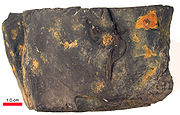
Coal oil
Encyclopedia

Shale oil
Shale oil, known also as kerogen oil or oil-shale oil, is an unconventional oil produced from oil shale by pyrolysis, hydrogenation, or thermal dissolution. These processes convert the organic matter within the rock into synthetic oil and gas...
used for illuminating purposes. Coal
Coal
Coal is a combustible black or brownish-black sedimentary rock usually occurring in rock strata in layers or veins called coal beds or coal seams. The harder forms, such as anthracite coal, can be regarded as metamorphic rock because of later exposure to elevated temperature and pressure...
oil is obtained from the destructive distillation
Destructive distillation
Destructive distillation is the chemical process involving the decomposition of feedstock by heating to a high temperature; the term generally applies to processing of organic material in the absence of air or in the presence of limited amounts of oxygen or other reagents, catalysts, or solvents,...
of cannel coal
Cannel coal
Cannel coal, also known as candle coal, is a type of coal, also classified as terrestrial type oil shale, with a large amount of hydrogen, which burns easily with a bright light and leaves little ash....
, mineral wax, and bituminous shale
Bituminous shale
Bituminous shale is an argillaceous shale impregnated with bitumen, often accompanying coal. It may contain kerogen; in that case it is classified as oil shale. When carbonaceous material is present in large amounts, bituminous shale grades into bituminous coal...
, while kerosene is obtained by the distillation of petroleum
Petroleum
Petroleum or crude oil is a naturally occurring, flammable liquid consisting of a complex mixture of hydrocarbons of various molecular weights and other liquid organic compounds, that are found in geologic formations beneath the Earth's surface. Petroleum is recovered mostly through oil drilling...
. A special type of coal known as cannel coal (classified also as terrestrial type of oil shale
Oil shale
Oil shale, an organic-rich fine-grained sedimentary rock, contains significant amounts of kerogen from which liquid hydrocarbons called shale oil can be produced...
) is required to produce it.
Coal oil was first produced in 1850 by James Young on the Union Canal
Union Canal (Scotland)
The Union Canal is a 31.5-mile canal in Scotland, from Lochrin Basin, Fountainbridge, Edinburgh to Falkirk, where it meets the Forth and Clyde Canal.-Location and features:...
in Scotland. He was the first to patent the process of distilling this cannel coal into kerosene. This industry thrived in Scotland, creating much wealth for Young.
It consists mainly of several hydrocarbons of the alkane
Alkane
Alkanes are chemical compounds that consist only of hydrogen and carbon atoms and are bonded exclusively by single bonds without any cycles...
series, having from 10 to 16 carbon
Carbon
Carbon is the chemical element with symbol C and atomic number 6. As a member of group 14 on the periodic table, it is nonmetallic and tetravalent—making four electrons available to form covalent chemical bonds...
atoms in each molecule
Molecule
A molecule is an electrically neutral group of at least two atoms held together by covalent chemical bonds. Molecules are distinguished from ions by their electrical charge...
, and having a higher boiling point
Boiling point
The boiling point of an element or a substance is the temperature at which the vapor pressure of the liquid equals the environmental pressure surrounding the liquid....
(175–325°C) than gasoline
Gasoline
Gasoline , or petrol , is a toxic, translucent, petroleum-derived liquid that is primarily used as a fuel in internal combustion engines. It consists mostly of organic compounds obtained by the fractional distillation of petroleum, enhanced with a variety of additives. Some gasolines also contain...
or the petroleum ethers, and a lower boiling point than the oils.
Early belief that kerosene was produced from coal led to kerosene being popularly referred to as "coal oil." This is a technicality, however, because hydrocarbons of the alkane series, with 10 to 16 carbon atoms, when refined, is the same thing whether taken from coal or petroleum.
Home remedy
Coal oil was once used as an internal and topical home remedy as a general cure-all for myriad ailments, including coughs, flu, cuts, abrasions, and wounds. Internal applications were administered by adding this decidedly toxic petroleum product to sugar cubes, molasses, honey or some other substance to mask the taste, while topical applications were applied adding to bandages or by pouring the coal oil directly on the affected area.See also
- KeroseneKeroseneKerosene, sometimes spelled kerosine in scientific and industrial usage, also known as paraffin or paraffin oil in the United Kingdom, Hong Kong, Ireland and South Africa, is a combustible hydrocarbon liquid. The name is derived from Greek keros...
- Patent medicinePatent medicinePatent medicine refers to medical compounds of questionable effectiveness sold under a variety of names and labels. The term "patent medicine" is somewhat of a misnomer because, in most cases, although many of the products were trademarked, they were never patented...
- Abraham Pineo GesnerAbraham Pineo GesnerAbraham Pineo Gesner was a Canadian physician and geologist who invented kerosene. Although Ignacy Łukasiewicz developed the modern kerosene lamp, starting the world's oil industry, Gesner is considered a primary founder. Gesner was born in Cornwallis, Nova Scotia...
, produced kerosene from coal, 1846 - Shale oil extraction

